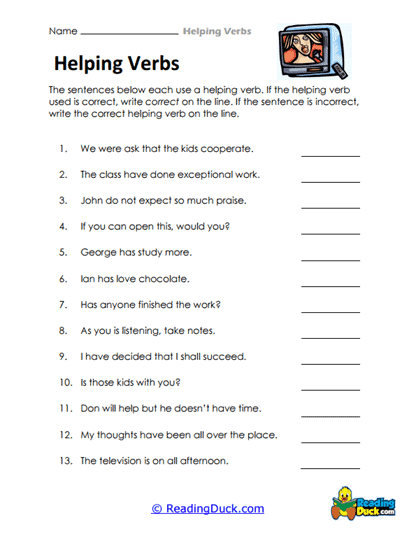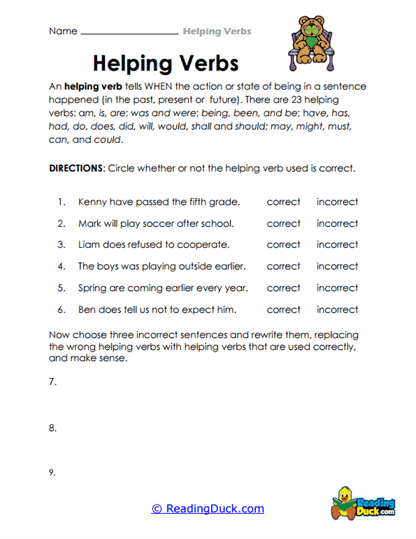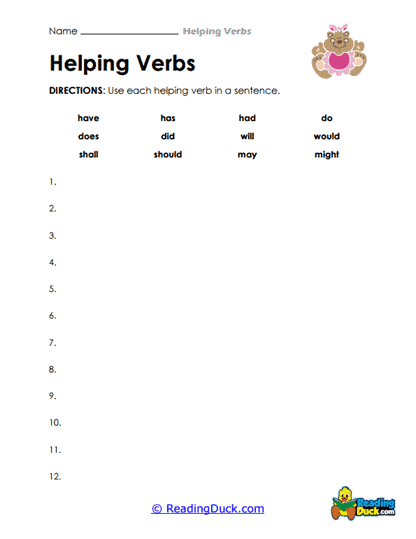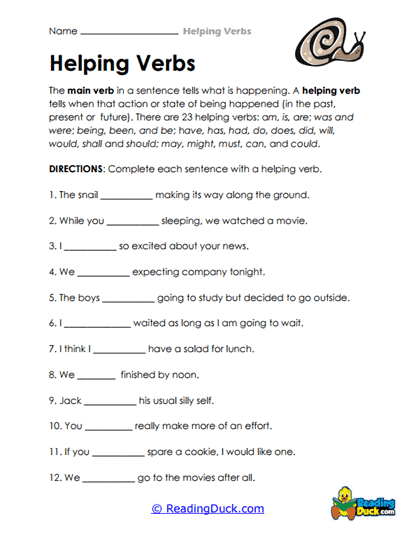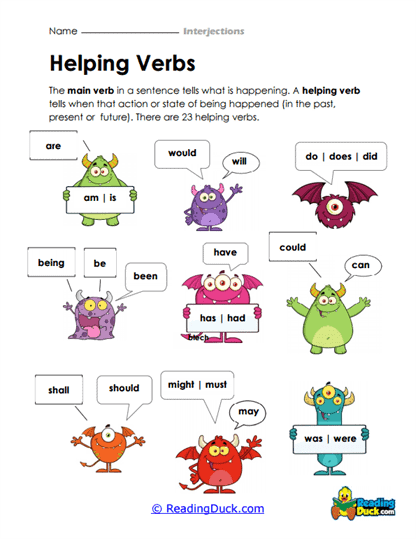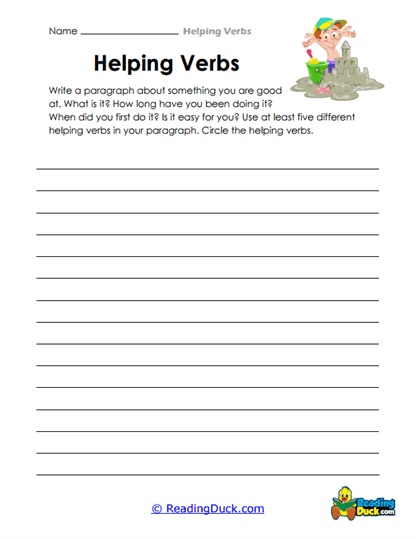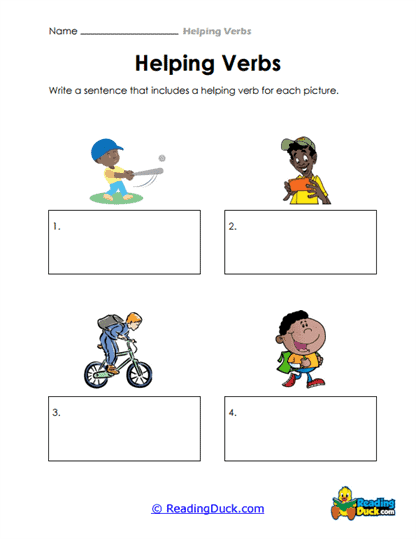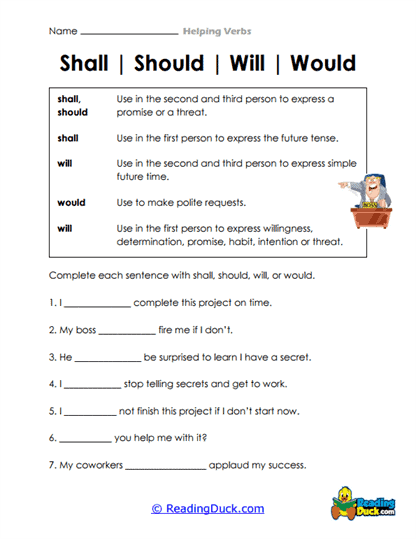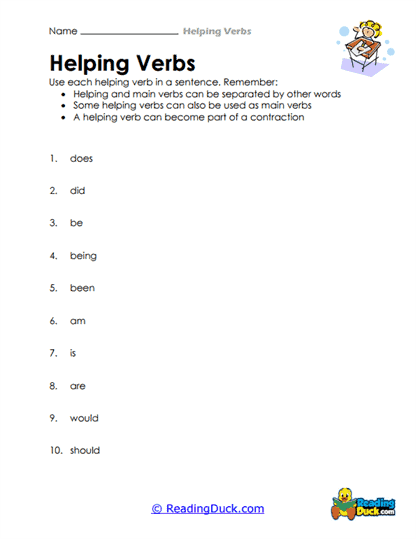Helping Verbs Worksheets
About Our Helping Verb Worksheets
Our collection of Helping Verbs Worksheets is meticulously designed to aid students in their journey toward mastering grammar, specifically focusing on helping verbs—a crucial element in constructing meaningful and grammatically correct sentences. Helping verbs (also known as auxiliary verbs) work alongside main verbs to indicate tense, mood, and voice, playing a pivotal role in enhancing clarity and precision in both written and spoken language. These worksheets are tailored to provide structured, engaging activities that support learners in building a strong foundation in grammar, ensuring steady progress in their overall language and communication skills.
Available in downloadable PDF format, each worksheet comes with an answer key, making them accessible for independent learning, classroom instruction, or homework assignments. This format allows both students and educators to benefit from an easy-to-use resource that promotes self-assessment, reinforcement of learning, and efficient review. With these worksheets, students can progressively improve their understanding of helping verbs, setting the stage for more advanced grammar skills and better overall language fluency.
Understanding Helping Verbs
Helping verbs, as the name suggests, assist the main verb in a sentence by extending its meaning. They provide important information about the tense (when the action is happening), voice (active or passive), and mood (expressing necessity, possibility, or obligation) of the action. Without helping verbs, many nuances in communication would be lost. Common helping verbs include:
- To be: am, is, are, was, were, be, being, been
- To have: have, has, had
- To do: do, does, did
- Modal verbs: can, could, may, might, must, shall, should, will, would
Helping verbs combine with main verbs to form various verb phrases. For instance:
- She is reading a book (Helping verb: "is," Main verb: "reading")
- They have finished their work (Helping verb: "have," Main verb: "finished")
- He can swim well (Helping verb: "can," Main verb: "swim")
These verb phrases enable more detailed and precise expression. They can indicate whether an action is ongoing (progressive aspect), completed (perfect aspect), or conditional (modal verbs). For example:
- I am running (ongoing action)
- She has eaten (completed action)
- We should leave now (necessity or recommendation)
Understanding how and when to use helping verbs is crucial for forming coherent sentences and conveying the right meaning. Without them, sentences would be either too simple or grammatically incorrect. Mastery of helping verbs helps students understand more complex grammatical structures, and it’s an essential step in developing fluency in language use.
Effective Strategies for Teaching Helping Verbs
Introducing helping verbs to students requires a combination of clarity and creativity. Teachers can employ a variety of methods to ensure students grasp the importance and function of helping verbs. Here are some practical strategies:
- Start with examples: Begin by showing students simple sentences without helping verbs (e.g., "She running") and then introduce sentences that include helping verbs (e.g., "She is running"). This allows students to see how helping verbs enhance meaning and clarity.
- Visual aids: Charts that list common helping verbs can be displayed in the classroom or provided as reference material. These can be paired with examples to demonstrate different verb forms.
- Sentence building exercises: Encourage students to build their own sentences by providing them with a list of helping verbs and main verbs. This hands-on approach reinforces their understanding of how helping verbs function in real sentences.
- Role-playing and storytelling: Assign students to create dialogues or short stories where they must incorporate helping verbs correctly. This not only strengthens their grammar skills but also boosts their creativity and language expression.
- Repetition and reinforcement: Grammar drills, quizzes, and group activities centered around helping verbs can be employed to reinforce the concept. Repetition in various contexts ensures that students internalize the rules and can apply them in different settings.
By blending traditional teaching methods with interactive, student-centered activities, educators can create an engaging learning environment where students feel confident in using helping verbs correctly.
The Role of Helping Verbs in Literacy Development
Mastering helping verbs significantly contributes to students' overall literacy development. As a core aspect of grammar, helping verbs serve as the building blocks for more complex sentence structures, which are necessary for clear and effective communication.
- Reading comprehension: Understanding helping verbs allows students to interpret verb tenses and actions accurately, improving their ability to grasp the meaning of texts. Whether they are reading stories, articles, or instructions, recognizing verb phrases enhances their comprehension of both the literal and nuanced meanings within a passage.
- Writing proficiency: In writing, helping verbs are essential for constructing coherent and grammatically correct sentences. They enable students to express time, mood, and voice, allowing them to communicate more effectively. For example, being able to distinguish between “I am writing” (ongoing action) and “I have written” (completed action) allows for precise and purposeful writing.
- Speaking and listening: In spoken language, helping verbs help clarify meaning and prevent misunderstandings. For instance, "I should go" implies a recommendation or obligation, whereas "I will go" indicates a decision or future action. The ability to use helping verbs correctly in speech enhances both fluency and comprehension during conversations.
Helping verbs are integral to a student's ability to use language effectively, contributing to stronger literacy skills across reading, writing, speaking, and listening.
Creative Activities to Reinforce Learning
To reinforce students’ grasp of helping verbs, educators can introduce supplementary activities beyond worksheets. These activities, suitable for both classroom and homeschool environments, can make learning dynamic and interactive.
- Helping Verb Bingo: Create bingo cards with helping verbs and main verbs. Call out a verb phrase (e.g., "is running"), and students mark the helping verb if it’s on their card. This fun game encourages students to quickly recognize helping verbs in a sentence.
- Verb Phrase Scavenger Hunt: Challenge students to find verb phrases in their reading materials or everyday surroundings (e.g., in books, advertisements, or instructions). Have them underline the helping verbs and explain how these verbs change the meaning of the sentence.
- Group storytelling: Have students collaboratively write a story, each contributing a sentence that includes a helping verb. This promotes teamwork while reinforcing the use of helping verbs in context.
- Charades with Helping Verbs: In this activity, students act out sentences where others guess the sentence based on the use of helping verbs (e.g., miming “She is swimming” or “He can dance”). This combines language learning with physical activity, helping students internalize the concept through action.
These activities are most appropriate for students in grades 3 to 6, where a focus on foundational grammar skills prepares them for more advanced language use in later grades.
The Importance of Helping Verbs in Everyday Communication
In summary, helping verbs are a fundamental aspect of grammar that plays a crucial role in language development. They are essential not only for constructing grammatically correct sentences but also for expressing the subtleties of time, voice, and mood. Helping verbs enable clearer communication, whether in academic writing, creative storytelling, or everyday conversations.
This collection of Helping Verbs Worksheets provides educators with a practical and accessible tool to support their students’ grammar education. Through structured exercises and answer keys, these worksheets allow for consistent practice and self-assessment, fostering an environment where students can progressively build their skills. Ultimately, a strong command of helping verbs empowers students to become more proficient readers, writers, and speakers, equipping them with the tools they need for both academic success and effective communication in everyday life.

